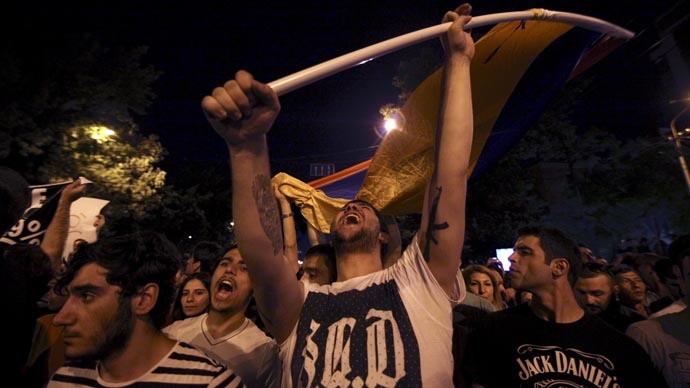Armenia police vow to stay put as long as protests remain peaceful

Protesters in Yerevan have spent another night on the streets of Armenian capital, facing an increased police presence, who have promised to refrain from using force as long as the crowd rallying against electricity price hikes remains peaceful.
Protesters, who have blocked off the road with garbage cans, continue to demand the cancellation of a 17 percent electricity price hike that is due to take effect on August 1. They have refused to meet with Armenian President Serzh Sargsyan to discuss their grievances, and instead chose to continue their sit-in that started last Friday.
As the rally (which had not been authorized by the municipality) continues, police in the city promised to refrain from using force as long as the protest remains peaceful. But police units have beefed up their presence, remain on high alert, and in the event of provocations or an emergency, have promised to use the means at their disposal to disperse the protesters.
According to organizers of the protest chief of Armenian Police Vladimir Gasparyan promised not to take any action against the protesters, as he visited the camp in an effort to deescalate the situation, Sputnik reports. Earlier on Wednesday, Yerevan's Deputy Chief of Police, Hunan Poghosyan said that while the protest was peaceful, law enforcement officers will not use force.
— Ilya Petrenko (@ilpetrenko_rt) June 24, 2015
The OSCE has meanwhile voiced its concerns over Armenian authorities’ commitment to protecting the rights of the demonstrators as they continue to block a major road in Armenia's capital, for the third night in a row.
“Armenia, like all OSCE participating States, has committed itself to protect and promote the fundamental freedom of peaceful assembly, and must fully respect the rights of the protesters in Yerevan to exercise this freedom,”said Michael Georg Link, Director of the OSCE Office for Democratic Institutions and Human Rights (ODIHR).
The director also urged “impartial” investigation into the clashes that took place on Tuesday morning when police prevented the crowd from marching on government buildings and dispersed the crowd. “Police measure has to be legitimate, necessary and proportionate,” Link said.
A tired policeman at the #ElectricYerevan protest. pic.twitter.com/Nvxo2hGqON
— Ilya Petrenko (@ilpetrenko_rt) June 25, 2015
Meanwhile Moscow hopes that answers will be found to the crisis in strict compliance with Armenian laws.
“We hope that answers will be found to all the problems in strict compliance with Armenian laws. We wish peace and prosperity to Armenia. We also wish it to settle all the differences,” Kremlin spokesman Dmitry Peskov said.
Being a close Russia’s ally bordered by hostile countries, Armenia is in a very vulnerable position, believes geopolitical analyst John Wight. While the situation in Armenia comes as a result of the “insanity of the free market,” Wight says internal crisis can quickly turn into a geopolitical one.
“There will have to be some kind of intervention [by Armenian government] to offset or ameliorate this hike in price, otherwise the domestic political and economic crises could quite quickly escalate to become a geopolitical crisis, given Armenia’s strategic location in the South Caucasus and the West’s propensity for involving itself in such matters,” Wight told RT. “The West, as we have seen, has shown a willingness and an eagerness to intervene in these matters, especially when it involves Russia.”
Regardless of whether the initial push for Armenian people to hit the streets was legitimate or not, some outside forces, particularly the United States, will not miss a chance to try and turn it to their advantage, believes Dr Paul Craig Roberts, the former US assistant secretary of the Treasury for economic policy.
READ MORE: Armenian protests resemble Ukrainian Maidan coup scenario - Russian MP
“This particular protest, they might be innocent, there may be a legitimate protest. But even if it is, Washington will make an effort to turn it into more,” Roberts told RT. “But even if it is a legitimate thing to protest, it does not mean that Washington won’t jump on it and turn it to its own purpose.”
“Sometimes Washington will originate the protest, other times it waits for one to happen,” Roberts said. “And then it puts its NGOs and various paid-for local politicians into the mix, and we saw this perfectly in Ukraine. And it happened in Georgia. All of these so-called color revolutions are a product of the National Endowment for Democracy funding of the NGOs in those countries.”
“That’s what going on, and people need to be aware of it,” Roberts warned. “So, what do they have to do: regulate these NGOs, or watch them, or terminate the foreign funding? I don’t know, but they need to be aware that is what they are used for. They are not there to teach democracy and human rights.”
Sit-in protest or picnic? pic.twitter.com/ZlUEHH3dWI
— Ilya Petrenko (@ilpetrenko_rt) June 24, 2015
While Armenia is a strategic pitch point between Russia, Iran and Turkey, for many people “if you say Armenia they don’t even know where it is on the map,” believes investigative journalist Tony Gosling.
“But that is part of the game here,” Gosling told RT, reminding his audience of numerous similar street protests over the past years, with Ukraine being a “classic” example. “The crucial thing is to look at the protest: is this a genuine protest or is it being orchestrated from outside?












